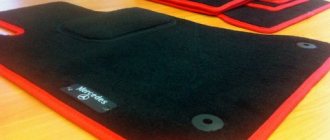Proper car care involves a whole range of procedures: washing the body and cleaning the interior, treating seals and locks, lubricating door hinges, and also caring for tires. In this case, tires require additional processing for the following reasons:
- aging and drying of rubber;
- loss of appearance;
Car tires are treated using compounds known as wheel blackeners. This product is based on glycerin. There are a large number of similar products on sale from various manufacturers, but the main disadvantage is their cost. A more cost-effective alternative is to make your own rubber dye. Read more in our article.
Why do you need to treat tires?
During vehicle operation, tires are exposed to road chemicals. Ultraviolet radiation also has a negative effect on rubber. In this case, the outer part of the wheel, which is constantly open, suffers more.
Even new tires after 5-6 months of active use begin to age, the rubber “dries out”, small cracks and delaminations appear. The deep black color gradually fades and turns into gray. The result is a decrease in tire service life and loss of appearance.
Moreover, washing the wheels does not solve the problem, since after drying the tires still remain gray. For these reasons, it is necessary to regularly blacken the rubber. The “ink” contains components that:
- penetrate deeply into the top layer of rubber and “moisten” the tires;
- protect rubber from exposure to ultraviolet radiation;
Tires remain elastic longer and crack less, the rubber acquires and retains a deep black color. In this case, blackening of the wheels must be done regularly, that is, with every body wash.
Of course, this operation is performed at car washes for an additional fee. If you wash the car yourself, the finished products are quickly used up. The solution is to make your own ink.
DIY methods for blackening rubber at home
If you decide to use one of the means described above, then the entire procedure for blackening rubber with your own hands is usually described on the packaging. Pay attention to the composition and indications for use, since some of the methods can only be used on the side of the wheel (those with a silicone base can reduce traction), and some are intended for preparation for long-term storage and are sprayed over the entire area.
You should immediately use a soft small brush, preferably a toothbrush. With its help, you can easily remove all dirt from the surface of the rubber. Then you can proceed to applying the product. Usually all preparations are sold with sprayers, so all you have to do is apply it to the surface of the tire and wait until it dries completely.
Please note the terms of use. You may need to heat the surface to be treated yourself. If the chosen product is in the form of foam, apply it in an even layer and wait until it dries completely. There are other, folk methods of blackening rubber with your own hands.
Blackening of rubber with glycerin
The most popular and affordable method of blackening tires. Glycerin can be bought at any pharmacy. Take 200 ml of the substance and mix it in equal proportions with water. Can be applied either by spray or with a damp soft sponge.
It has a good aesthetic effect, but has several significant drawbacks. The main one is the effect on rubber, as a result of which, in conditions of low humidity, the material dries out and can crack. Glycerin is sweet, so the wheel will immediately become covered with a small layer of dust. It washes off with water without much effort.
By maintaining different proportions, you can achieve different effects. The higher the glycerin content, the more shiny the tires will be.
Using laundry soap
Blackening rubber with laundry soap is widely popular due to its availability. All you need is soap, water and a soft brush. The only significant drawback of this method is the effect of soap - with regular long-term use, the rubber will become dry and crack.
Thoroughly clean the tires of dirt and immediately soap them well. Then clean again with a medium-hard brush. You can also grate the soap into small pieces and dissolve in warm water. The resulting solution is rubbed into clean rubber.
Shoe polish as a blackening agent
Shoe polish does not have the same shine as other described substances. Dry shoe polish can be slightly diluted with kerosene. Another disadvantage of applying shoe polish is the time required for complete drying - up to two hours. Therefore, the only advantage of this method is its accessibility.
How to blacken tires on a car
Some of the most common products that can be used to blacken tires include:
- laundry soap;
- shoe polish;
- silicone;
- glycerol;
These solutions allow you to get a fairly good visual effect. After treatment, the tires become black, which improves the appearance of the car. However, do not forget about the shortcomings. In other words, it is important to consider certain pros and cons of each method.
Laundry soap for blackening wheels
To treat tires with soap, you need to prepare a medium-hard brush, 70% soap and water. Before processing, the rubber must be washed, after which the brush is lathered with soap, moistened with water and the tires are rubbed.
You can also grate the soap, dissolve it in water, and then rub the solution into the rubber with a brush. The result is that after processing and drying, the rubber will be deeply black.
As for the disadvantages of the method, there are no advantages other than the visual effect. Soap does not provide rubber protection. Moreover, laundry soap dries out the rubber, shortening its service life. This means this method is not suitable for frequent use.
Shoe polish for tires
Shoe polish is also a tool that allows you to achieve the desired visual effect. Colorless gloss, black cream paint, and shoe polish are suitable for processing.
Before treatment, the tires are washed and dried, after which the product is applied to the surface of the tires with a sponge or shoe brush.
As a rule, shoe paint lasts well and for a long time. As for the disadvantages:
- Shoe polish is more expensive than soap;
- rubber is not particularly protected from ultraviolet radiation;
- Wheels must be washed and dried before application;
- drying is needed after processing (so that the paint dries);
In practice, when choosing this method, up to 20-30 minutes are spent just preparing the tires and drying the paint after application.
Rubber treatment with silicone
Silicone PMS-200 is suitable for blackening tires. The wheels need to be washed, then silicone should be applied with a sponge. Silicone adheres well to tires (better than soap and shoe polish). One of the advantages is good UV protection.
This property makes it possible to process tires not only for blackening the rubber, but also for seasonal storage of tires (lubricating the surface for moisturizing).
As for the downsides, PMS-200 silicone is quite expensive compared to other products.
Blackening of rubber with glycerin
Automotive stores offer many products for “blackening” rubber, both expensive and relatively cheap. However, if you carefully study the composition, glycerin is the basis everywhere. The cost of glycerin in a pharmacy is several tens of rubles, while ready-made ink will cost 10 times more.
Glycerin itself is a polyhydric alcohol in the form of a viscous transparent liquid. It is obtained by hydrolysis (splitting) of vegetable oils and natural animal fats. Glycerin easily dissolves in water and dissolves well a number of substances.
Glycerin is actively used in the food and household industries, etc. It is used for the production of cosmetics, medications, antiseptics, etc. It is also used for processing leather and fabrics. Glycerin has also found its use in auto chemicals. A large number of car cosmetics also contain glycerin, including tire ink.
Recommendations for use
All the methods are simple and easy to remember. You can safely go to the pharmacy for a magic bottle, but finally, adopt a couple of tricks, they will definitely come in handy:
- if you overdo it with glycerin, it is easily washed off with water;
- Buy concentrated liquid at the pharmacy, and then prepare solutions from it at home;
- depending on the concentration of the substance, different effects are achieved: for example, if glycerin is diluted with water in a ratio of 1:5, the effect will be shiny; with a less strong dilution, for example, 1:3, the effect will be matte;
- It is worth polishing the interior and body no more than once a month;
- If the car windows fog up, dilute the substance with alcohol in a ratio of 1:10 and apply the mixture to the glass. There will be no more fogging.
Glycerin is absolutely safe for both cars and humans. You can use it without gloves, because the substance is included in many creams. The product is indispensable for a car; it will become your assistant for a long time.
Every driver wants his car to look neat and well-groomed. Wheels also play an important role in the car’s exterior, which avid gourmets tune to their heart’s content. However, standard modern wheels can look very attractive if they are clean and well-maintained. In addition, today the market offers specialized automotive chemicals for blackening rubber, which not only gives the tires a rich black color and shine, but also prevents road dust and dirt from sticking to it.
So, to make the tires look like they did on a show car, you can use a special rubber blackening agent, the cost of which starts at 200 rubles. We suggest you familiarize yourself with cheaper options that you can do yourself at home, saving a lot of money.
Glycerin ink: how to make and apply
To make tire ink, just buy a few small bottles of glycerin at your nearest pharmacy. Glycerin must be diluted with water. You can do this at your own discretion, however, experienced car enthusiasts recommend a 1:1 ratio (use 50 ml of water for 50 ml of glycerin).
- Before treatment, tires should be washed thoroughly (preferably using detergents). Then the wheel must be thoroughly dried;
- The prepared solution is poured into a container with a spray bottle (can be from a window cleaner, etc.) and the ink is sprayed onto the surface;
We also recommend reading the article about what problems are indicated by tire tread wear. From this article you will learn how you can determine possible problems with the chassis by the nature of tire wear, as well as what to look for when assessing the wear of your car tires.
Durability and efficiency
After treatment, the surface of the wheel quickly turns black, as glycerin is actively absorbed into the upper layers of rubber and also dissolves dirt embedded in cracks and depressions. Moreover, glycerin forms a glossy film, giving additional shine.
Immediately after application, a lasting effect is observed in dry weather (provided you drive on dust-free roads) for up to 8-10 days. If the weather is damp, treatment is enough for 1-2 days. The reason is that glycerin is washed off and dissolves in water.
Blackening of rubber with glycerin
The most popular and effective homemade solution for blackening tires involves the use of glycerin, which can be found over the counter in every pharmacy. Standard jars of this substance are 25 and 40 milliliters. You will need about five of them, 25 ml each, or three, 40 ml each, respectively.
After purchasing glycerin, you need to find a container with a spray bottle, like those in which glass cleaners are sold. Glycerin is poured into it along with water. The traditional recipe involves mixing these ingredients in a ratio of 50 to 50. This composition will be liquid and at the same time effective.
On the other hand, some prefer a fatty solution with five parts glycerin to three parts water. Unlike the first option, here the resulting liquid will not need to be sprayed, but applied with a sponge previously soaked in the solution. In addition, it is quite obvious that in this case, with an equal amount of glycerin, the final product will be less.
Recommendations
Considering the cost of glycerin, as well as the relatively low consumption and excellent effect, this method is one of the best in terms of quality and price. For this reason, it is recommended to treat rubber with glycerin regularly.
We also recommend reading the article on how to choose the right car tires based on their markings. From this article you will learn what tire markings mean, as well as what features you should pay special attention to when selecting tires for your car.
It is also advisable to periodically treat tires with silicone to preserve the appearance and protect the surface of the tires from exposure to ultraviolet radiation and “drying out.”
Combined with proper rubber storage conditions, the overall service life of car tires can be significantly increased with this approach.
How regularly can you blacken rubber?
Tire blackening can be done at least every day if you use traditional processing methods. However, if you use the traditional method of treating with glycerin, it is recommended to perform the process no more than once, since glycerin is an aggressive chemical that leads to deformation and cracking of rubber with regular use.
Blackening is recommended when the tire begins to fade. For example, in order to preserve the wheels before the new season, it is necessary to perform similar treatment. Car tires are the most susceptible to cracking, so it is necessary to analyze treatment methods that can protect the wheel and give it a black tint.











